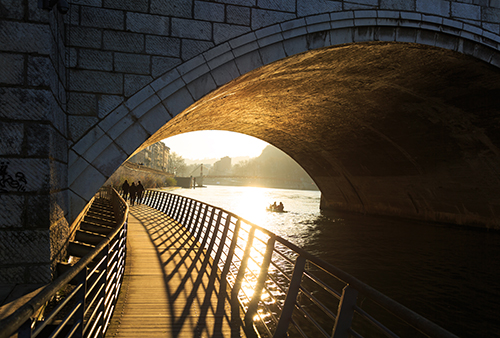| Mysterious Ways: The thrills and new perspectives of urban kayaking3 April 2017 Kayaking has a lot going for it as a means of exercise. High intensity, low impact, great for core workouts and aerobic respiration, it’s perfect for people with limited flexibility, soft-tissue injuries, or conditions like arthritis. Now the sport has gone urban, with people taking to city waterways for a new take on exercise where they can escape the sprawl without actually leaving it. Urban Kayaking? Pull the Other OneNo, really, it’s a thing! People are already doing coastal kayaking, sea kayaking, white-water kayaking, long distance kayak expeditions, and river kayaking, so it shouldn’t come as a surprise that people living in cities would want their share of the fun too. With recent developments in collapsible, portable kayaks like the Oru Bay Plus, it’s easy for anyone at all to get into urban kayaking. Most major cities have a network of waterways of canals and rivers that were originally used by barges or boats, so it makes sense that people would see the appeal in traversing the urban landscape via kayak. One of the biggest parts of its appeal is the ability to see a city from a different perspective that very few of us consider, escaping into solitude and tranquility.
There are even people that do night-time kayaking, which affords yet another chance to see our surroundings in a light (or darkness) we haven’t seen before. The point is that kayaking is now a multi-faceted past-time that has benefits that come from both the physical as exercise, and the mental as stress relief.
Why Kayak?The myriad benefits of kayaking are well established. Proper kayaking technique works numerous sets of muscles all throughout the core, from the upper thighs and glutes all the way up through the abdomen to the deltoids and trapezius (conversely, incorrect technique can lead to injury, so it’s not recommended). It’s estimated that kayaking can burn on average 350 calories in normal conditions, and that number can reach 600 in rougher conditions. You can also crank up the difficulty level by increasing the weight of the kayak with ballast. Paddling against the tide or a headwind can take it up a few notches too.
On the psychological side of things, people do it simply because it’s fun. The stale, unchanging environs of the gym can throw its sheer repetitiveness and boredom into dull focus. A big part of kayaking’s appeal comes from the variation and discovery via the simple enjoyment of touring areas of interest with pleasant surroundings, from a perspective that running or cycling can’t reach. Who Can Kayak?Pretty much anyone can kayak, and with the low impact it has on the body, especially the joints, it’s ideal for people carrying injuries or looking to avoid them. People who have to put limits on physical activity, such as older people with flexibility or joint issues, and arthritis sufferers, will find it particularly beneficial. Logistically speaking, you obviously need to be located near a stretch of water that will allow you to paddle some distance. In the UK, you’ll also need a licence from the Canals & Rivers Trust.
Don’t You Need to Lug About Lots of Equipment to Kayak?Nope! With the rise in popularity of urban kayaking, there have recently been exciting new developments in kayaks designed just for it, especially for those who don’t want to have to transport big, cumbersome, traditional ones around. A lot of people in cities either prefer not to drive, or just don’t like being laden down with lots of gear. The best example of this is the Oru Bay Plus, a cutting-edge piece of kit. Simply, it’s a sleek, speedy 12-foot kayak that you unfold and put together entirely in five minutes from a 12-kilogram pack that you can carry on your back. Where Can I Go with This?Anywhere you like. The great thing about the Oru Bay Plus is that it’s perfect for urban kayaking as well as sea, coast, long distance or river kayaking. The only real limit is where the water meets the land. Once you’ve toured the cities in the UK like London, Edinburgh, Glasgow, Birmingham, Norwich or Cardiff, you can go further afield and try the many cities of Europe, Canada, the USA, and many others . Did you find this article helpful, or perhaps have something to add? We welcome you to post in the comments to give us your perspectives or suggestions. | ||||||||




















